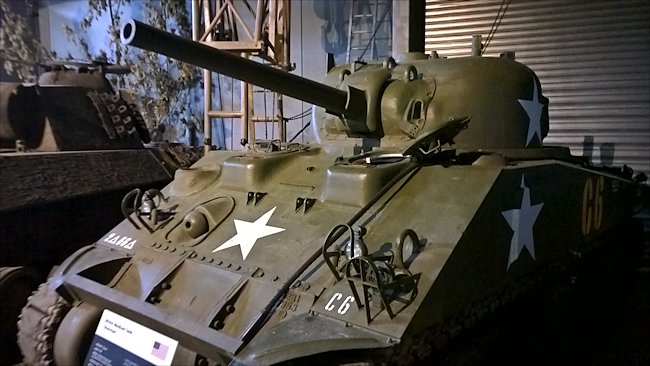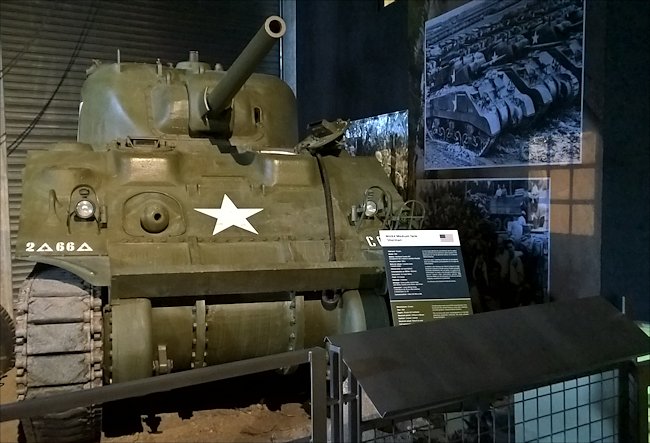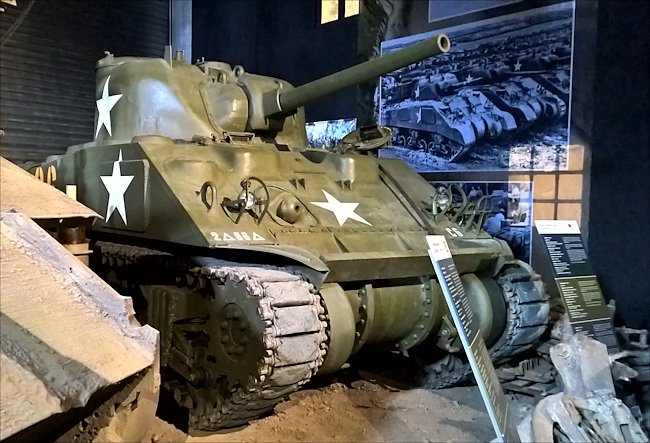Overlord Museum M4A4 Sherman Tank
This Sherman M4A4 tank contrasts dramatically with the other Sherman M4A1 76mm tank on display inside the Overlord Museum. It has a welded hull not a rounded cast tank chassis. It is also only armed with the short barreled standard 75mm gun that could not penetrate the frontal armour of a German Panther or Tiger Tank. On D-Day 6th June 1944 there were more of these types of tanks in the Allied Armoured Divisions than any other.

M4A4 Sherman Tank Overlord Museum 1944 D-Day Colleville-sur-Mer Normandy
Location
The nearest village to the Overlord Museum is Colleville-sur-Mer. It is on the D514 costal road Hameau du Bray. You cannot miss it as there is a M4A1 Sherman tank, M10 Wolverine Tank Destroyer and British Sexton self-propelled artillery gun outside the front by the roundabout. It is very near Omaha Beach and the American Military Cemetery.
Specification
The M4A4 Sherman was powered by a Chrysler A57 multibank petrol engine that produced 470 hp. The tank needed a slightly longer hull to fit the engine. It had a maximum road speed of 30 mph (48 km/h). The tank had an operational range of around 120 miles (193 km) before it needed refueling. It needed a five man crew: commander, gunner, loader, driver, co-driver/machine gunner. They were protected by armour that ranged in thickness from 25 mm to 76 mm. Between July 1942 and November 1943 7,499 M4A4 Shermans were manufactured
The tank was armed with a standard 75mm gun that could fire high explosive HE artillery rounds as well as armour piercing AP shells. It could penetrate the frontal armour of a Panzer IV tank but not the front armour on the Panther or Tiger tank. To do any damage to their side or rear armour they had to get close. The tank was also armed with two 30-60 Browning M1919A machine guns. One was next to the main gun in the turret whilst the other was in a ball mount in the hull.

The ledge at the front of the tank was used by the crew to stack sand bags and extra tracks to give added protection from enemy shells
M4 Sherman Tank Development
Design of the Medium Tank M3 had been undertaken as a development of the M2A1 on the clear understanding that it was to be considered as an interim design to get a tank with 75mm gun armament into production and service as soon as possible. While design was carried out on the M3 Lee Tank the Armored Force Board drew up requirements for its successor with a 75mm gun in a fully traversing turret.
Final M3 working drawings were completed in March 1941, and Rock Island Arsenal offered the Armored Force Board five suggested schemes for the M4 at a meeting the following month. The most straightforward scheme was selected, which entailed using the M3 medium chassis, suspension, power unit, transmission, and other mechanical parts, unchanged, and providing a completely new hull top, either cast or welded, with a central turret mounting the 75mm gun.
The 37mm gun was discarded but a machine gun cupola was to be retained on the new turret. Doors were provided in each side of the hull as in the M3. Designated Medium Tank T6, this vehicle was built in wooden mock-up form in May 1941 for Armored Force Board approval, and a pilot model, with cast hull and detail changes which included elimination of the cupola, was completed at Aberdeen Proving Ground on 19th September 1941.

M4A4 Sherman Tank 75mm was one of the most common tanks in Normandy 1944. They landed on Gold, Juno and Sword Beach.
It is tempting to suggest that the T6 was influenced, if not copied to some extent, from the Canadian Ram (qv) in view of its similarity. Documentary evidence (and the chronology of events) disprove this, however. An early production Ram was sent from Montreal Locomotive works in July 1941 for tests at Aberdeen Proving Ground which lasted until October that year, but APG's report on the Ram was concerned only with its comparison to the M3 and offered no comment on its relevance to the T6 design.
Meanwhile the German invasion of Russia in July 1941 indicated that American involvement in the war in Europe would increase in the year ahead. On President Roosevelt's personal orders tank production- schedules for 1942, provisionally set at 1,000 medium tanks a month, were doubled. To achieve this, additional production facilities were required and Pacific Car and Foundry, Fisher, Ford and Federal Machine and Welder were added to the list of plants earmarked to build the new medium tank.
In October 1941 , the T6 was standardised as the Medium Tank M4 and plans were made to introduce the M4 on to the production line, in those plants building M3s, at some convenient point early in 1942. This would mean that M4 medium tanks would be built at a total of 11 plants in 1942. A major proposal was that a second purpose-built tank production plant be built on the lines of Detroit Arsenal.
In September 1941 Fisher were asked to erect and operate such a plant at Grand Blanc, Michigan. Building of Grand Blanc Tank Arsenal, designed from the start to turn out M4s, was started in January 1942 and tank production commenced the following July, though Fisher had, meantime, commenced building M4s in one of their existing plants. The M4 pilot model was built by Lima Locomotive works in February 1941, differing from the T6 principally in the elimination of the hull side doors. Full production in three plants, Lima, Pressed Steel, and Pacific Car and Foundry started the following month, all these initial production types being cast hull vehicles, designated M4Al.
By the autumn of 1942 all other plants in the programme were in full production, and in October 1942, at the Battle of Alamein, the first M4 mediums went into action with British forces. The M4 series was the most widely produced, most widely used, and most important of all tanks in service with American, British, and allied forces in World War Il.
While not necessarily the best Allied tank in qualitative terms, and certainly inferior in armour and hitting power to the best German and Soviet tanks, the M4 medium tank (popularly known by its British name of Sherman) had the virtues of simplicity of maintenance, reliability, speed, ruggedness, and an uncomplicated design.
These were most important factors for a vehicle being mass-produced in commercial plants with no background of military experience in peace-time, for use largely by conscript troops with training time limited by the needs of war. In terms of cost-effectiveness, the M4 Sherman was supremely suited to the needs of the hour, a fact reflected in the total output of more than 40,000 tanks (and associated AFVs) based on the M4 chassis in the years 1942-46. Shermans were used by every allied nation in every armour role on every fighting front.
The Medium Tank M4 had the same basic chassis as the M3 medium, with vertical volute suspension, rear engine, and front drive. Apart from very early models, the bogies were altered, however, so that the return rollers were set behind, instead of on top of, the spring units. Hull was either welded, cast, or welded with cast/rolled nose, as detailed in descriptions of the different models, while the 75mm gun was set in a simple cast turret and provided with a gyro-stabiliser as in the M3.
Initially the engine was a Continental R-975 air-cooled radial type, but an ever-persistent shortage of this Wright-built power unit (which was essentially an aircraft engine and needed as such by the aero industry) forced the adoption of alternative engines, giving rise to the main production variants. The M4 Sherman had a five man crew, could fire AP or HE shot, had a maximum armour thickness of 50mm (more on reworked and late models), had controlled differential steering, weighed from 33 (short) tons, gross, and had a top speed of 24-30mph according to model. There were numerous detail changes in models during their production life and these are detailed for individual types.
D-Day 1944 books

